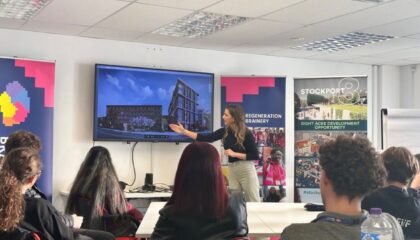A smart operating system for building automation that saves carbon and reduces its operational energy consumption surely remains something of a holy grail? Maybe not, as Tim Clark reports in Build in Digital.
How do you save 1.1trillion mobile phone charges? Or better still, accumulate over £3.5m in energy savings for building owners, simply by managing buildings that little bit better?
A trillion phone charges – or 11m kilowatt hours (kWh) – is the kind of number that can feel plucked out of the air; so mind-boggling in size that it defies belief. However, Workman has rolled out an integrated system to help solve the riddle of power use in buildings, and has reaped the rewards.
Build in Digital quizzed the brains behind the IBOS venture, James Hallworth, Partner and Head of Building Technology at Workman, on how the company managed to convince landlords and occupiers to allow them to manage over 7m sq. ft of space. Launched in May 2021, IBOS stands for Intelligent Building Operating System and is designed to enable the automation and optimisation of buildings’ operations to make them smart.
Building automation: a collaborative venture
Developed in collaboration with technology partner Bubll Automation, the system utilises cutting-edge IoT technology to allow automated operations, remote engineering capabilities, and effective data analytics of building systems. Both landlords and tenants are becoming increasingly aware that they will need to monitor the energy use of their buildings more closely in the coming years.
By 2027 the EPC [Energy Performance Certificate] level of commercial buildings will have a minimum “C” standard, and the government has published a commitment to raising that to “B” by 2030.With the middle of the decade on the horizon, commercial landlords have woken up to the fact that unless they upgrade their stock, they could be left with what are known as stranded assets – buildings which they are unable to rent due to their poor energy performance.
“I was getting asked more and more often to integrate smart technology into projects and the issue always came at the end of the project,” says Hallworth.“The smart technology providers always said ‘yeah sure we can integrate with the building, it’ll be fine’ and then the development would start and the costs simply skyrocketed.
“Smart technology (as a phrase) was being bandied around but it wasn’t really being focused on our actual clients and their requirements in terms of net zero and ESG. So we went about looking at how we could fill that gap which is getting that data out of the building and getting in better control.”
Allowing building owners better control is a key aspect of the IBOS system. Workman trialled the system for two years with a number of key partners to make sure that any bugs were ironed out before launching it on the market. Workman has managed to develop a holistic wraparound service that has managed to build in fail-safe to the usual problems that dog “smart” building technology.
The approach has meant that the firm has needed to be forthright with their clients on how to get the most out of their buildings.
“Instead of dumping the technology with the site team [for a building] and saying ‘here you go’, it’s been very much a hands-on, face to face approach that we have taken,” he says. “We can go into buildings with or without a BMS [Building Management System], take the data out and put in algorithms over the top of it to make it work in a really fantastic way and smart way. But if you are simply passing that data to someone who doesn’t have the technical knowledge, then the savings simply aren’t going to happen.”
Simple failures
Smart buildings, intelligent building management systems, and other technologies are however only as efficient as those who operate them. As a service provider Workman, and its technical partner, have looked to educate building operators on how to get the best out of a system.
The challenge remains that many landlords aren’t clear how they can implement smart building technology. The work is often handed over to FM teams who Hallworth says lack the proper training or technical knowledge to make sure the technology works as well as it can.
“We will often be rolled out to speak with the tenants, and explain what we’ve been doing. Organising landlords is only one part of the problem; we want both parties to work in a collaborative way and begin sharing data,” Hallworth adds. “Our technology is really unique, but if you just pass that onto someone without technical knowledge in terms of how to do algorithms or write formulas, then the improvements [in building function] just aren’t going to happen.
According to Workman, IBOS typically takes around two days to install, with data accessible within two weeks and energy savings of at least 20% usually identified within the first three months. The system is operating in 60 buildings across the UK, and has proved commercially viable in spaces as small as 3,600 sq. ft, as large as 1.5m sq. ft and in both vacant and fully occupied units.
It can also be installed across portfolios as well as individual properties. The system is one of what will become a whole suite of products that aim to solve the landlord’s energy riddle.
At Republic’s Import Building, a 270,000 sq. ft scheme managed by Workman on behalf of Trilogy Real Estate LLP, IBOS has been installed for one year. Over the past 12 months, it has delivered a 20% energy saving, which translates to 254,000kg of CO2 eliminated, and a cost saving of over £430,000.
May Molteno, Head of Social Impact and Republic Education Eampus, for Trilogy Real Estate LLP, said: “To achieve our EPC and Net-Zero pathway goals, Trilogy recognises that significant opportunities lay in the optimisation of building controls to ensure equipment is operating efficiently, and at appropriate times.
“By implementing IBOS, Trilogy continues to maximise efficiencies, aligning to Net Zero interventions within our sustainability strategy.”
Full spectrum visibility
How has the IBOS system been able to save 2.5m kg of CO2; what is it about the technology that made that change?
“There are obviously some low hanging fruits for us,” Hallworth says, mentioning simple energy-saving measures that are easily put in place.
“But essentially what we’re able to do is really open up the building in a really granular way.”
The difference from a normal building management system (BMS) is that IBOS can pull out all the data points from a bit of plant machinery, understand all the unique parts of that piece of kit, and is able to formulate the data 24 hours a day, seven days a week.
“We’re able to get full visibility of exactly how a building is working down to finite detail, then understand it, visualise it, and pull together a strategy with the site team and do a trend analysis, then make lots and lots of really small tweaks and optimisations.”
Small changes over time add up, and as Hallworth states, it challenges the building operators to find where they can make savings. A lot of the time, he says, many building owners think their plant machinery is optimised when it isn’t.
“We had a building in London, the BMS was saying all the heating units were off, there’s no demand, but there were 10 rogue units where the software had failed, and though the BMS was showing that everything was operating as it should, it wasn’t.”
The glitch in the system saw the rogue units work both the chilled water and hot water systems at the same time, acting as Hallworth says “like heat exchanger”, and using a lot of energy for no purpose.
Workman currently has 25 separate clients within its IBOS portfolio, and has installed the system across offices, shopping centres and industrial facilities.
This article originally appeared in Build in Digital.
Key highlights from individual assets include:
- £314,000 annual cost saving at a 90,000sq. ft London office, equating to 337 tonnes of carbon.
- 580,000 kWh annual energy savings (32%) at a 380,000 sq. ft shopping centre.
- £750,000 annual cost savings at a 140,000 sq. ft office scheme in Uxbridge, cutting carbon by 560 tonnes.
- 250 tonnes annual carbon savings at a 270,000 sq. ft London office.
IBOS was initially conceived when Workman partnered with software developers Bubll Automation to create a digital platform to automate and optimise building performance.
After 18 months of development and testing in buildings with different levels of infrastructure and technology, Workman launched IBOS in May 2021.
Find out more about how it works in this short video:



